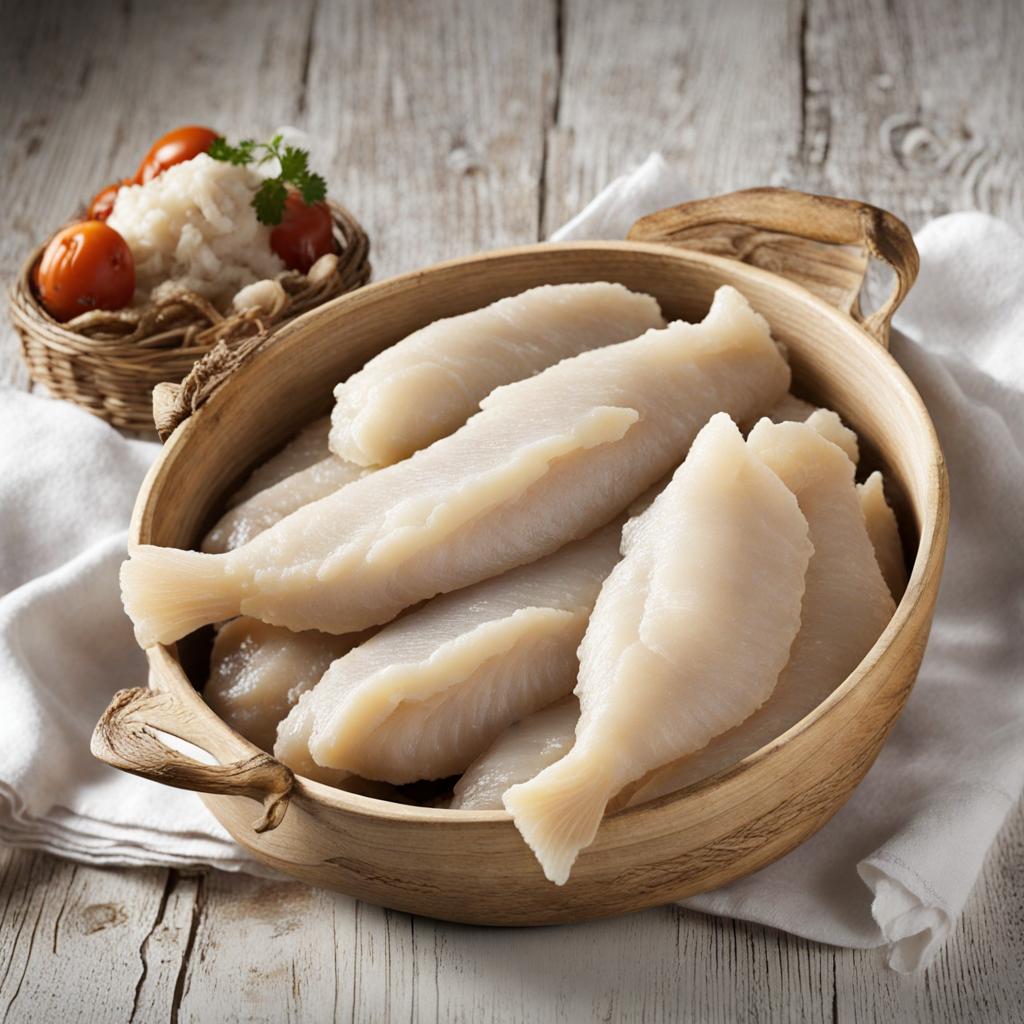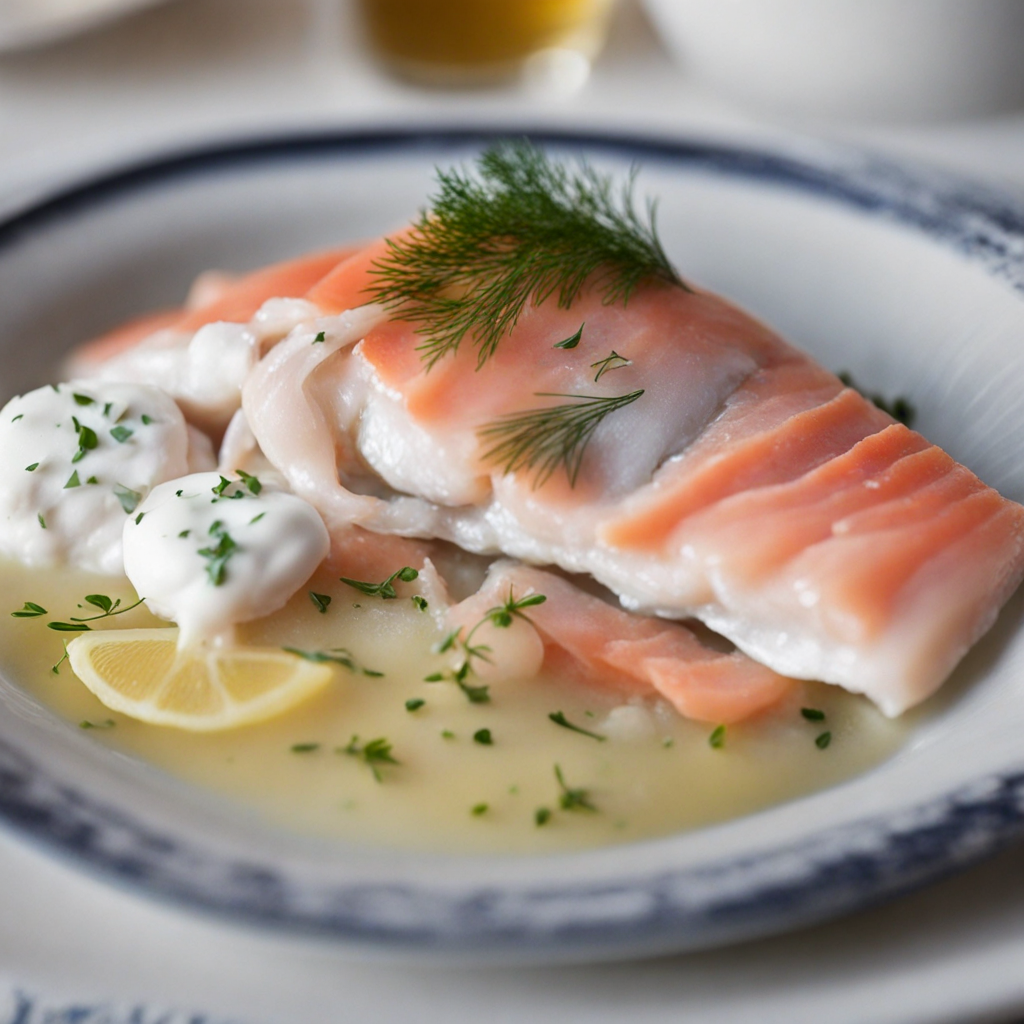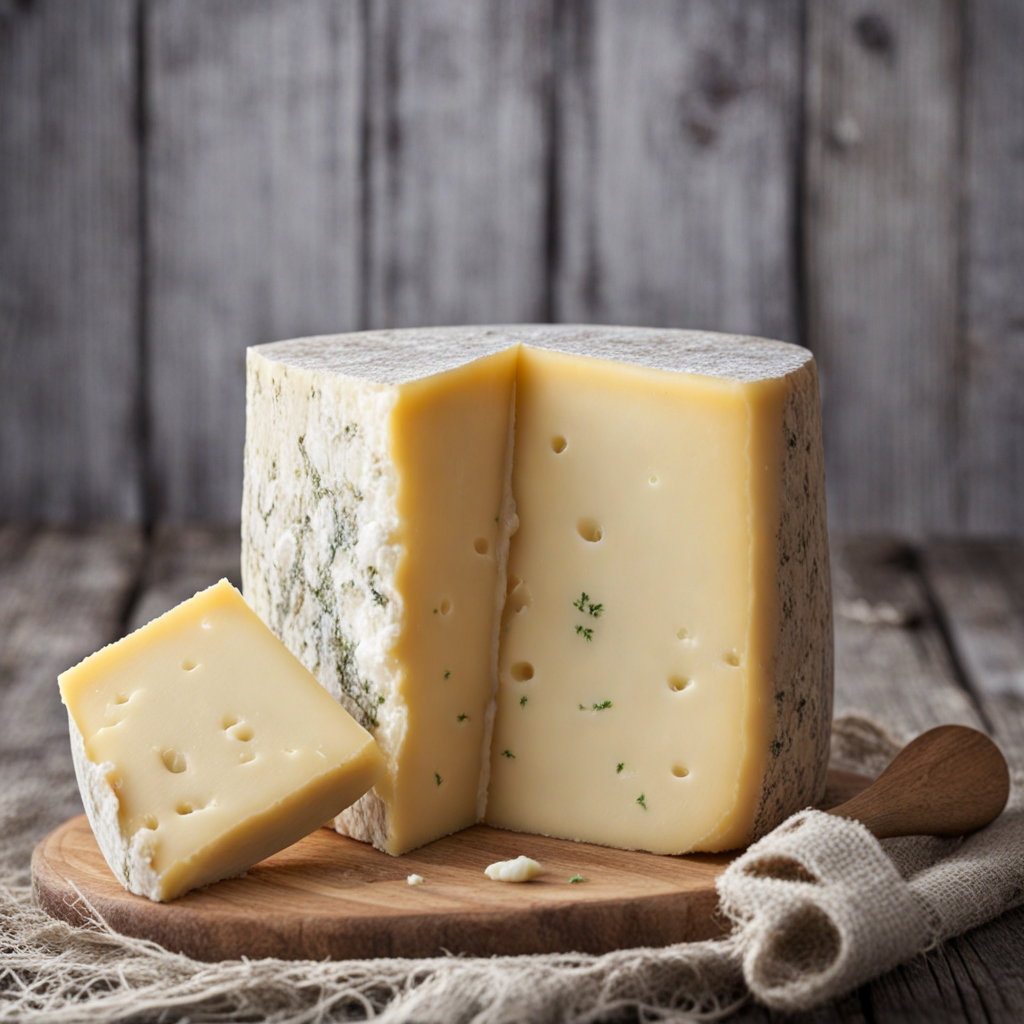Lutefisk
Lutefisk is a traditional Norwegian dish that embodies the spirit of Scandinavian cuisine. It is made from dried cod that has been soaked in a lye solution, giving it a unique texture and flavor profile. The process of preparing lutefisk is quite fascinating, as the fish undergoes a transformation that results in a gelatinous, almost jelly-like consistency. This unusual texture can be a point of contention for some, but it is celebrated by many who appreciate its historical significance and cultural roots in Norway. When served, lutefisk is typically accompanied by a variety of traditional side dishes, including boiled potatoes, mushy peas, and a rich white sauce, which helps to enhance the flavor. The dish is often garnished with crispy bacon or melted butter, adding a savory element that balances the fish's mild taste. For those who enjoy a hint of acidity, some choose to drizzle lemon juice or vinegar over their serving, which brightens the overall experience and cuts through the richness of the dish. The flavor of lutefisk is subtle yet distinctive, often described as slightly fishy with a hint of sweetness. While its unique preparation process may not be for everyone, it offers a taste of Norway's culinary heritage that is worth exploring. For adventurous eaters, lutefisk provides an opportunity to experience a dish that has been enjoyed for centuries, and it often brings people together during the holiday season, making it a truly communal dining experience.
How It Became This Dish
The Enigmatic Journey of Lutefisk: A Culinary Tradition of Norway #### Origins: From Preservation to Tradition Lutefisk, a dish with an intriguing blend of history and cultural significance, traces its roots back to the ancient methods of food preservation. The name "lutefisk" is derived from the Norwegian words "lute," meaning "lye," and "fisk," meaning "fish." This unique dish primarily consists of dried white fish—traditionally cod—that has undergone a remarkable transformation involving lye, a caustic soda solution. The origins of lutefisk can be traced back to the Middle Ages, a time when northern European societies were grappling with the challenges of food preservation. Fishing communities relied heavily on drying fish as a means to extend its shelf life. The cod, abundant in the icy waters of the North Atlantic, was particularly favored. However, the harsh winter months necessitated additional preservation techniques. It was during this period that the use of lye emerged, likely as a method to rehydrate the dried fish while also rendering it safe for consumption. The earliest documented references to lutefisk date back to the 16th century, with mentions in both Norway and Sweden. The process involved soaking the dried fish in cold water and then treating it with lye, which gave the fish a gelatinous texture. Afterward, it was rinsed thoroughly to remove the lye and then cooked, resulting in a characteristic dish that was both unique and somewhat controversial due to its intense aroma and texture. #### Cultural Significance: More Than Just a Meal In Norway, lutefisk transcends its role as mere sustenance; it embodies a cultural tradition that is steeped in community and familial ties. Traditionally served during the Christmas season, it has become a staple at holiday feasts and gatherings. Families often come together to prepare and share lutefisk, fostering a sense of unity and nostalgia. The preparation of lutefisk has evolved into a ritualistic practice, with specific techniques passed down through generations. Lutefisk also holds a place in the hearts of Norwegian expatriates, particularly in the United States, where Norwegian immigrants brought their culinary traditions. In towns with significant Norwegian populations, lutefisk dinners have become popular communal events, often featuring a blend of traditional Norwegian dishes and American influences. These dinners serve as a reminder of home, allowing participants to reconnect with their heritage and celebrate their ancestry. The dish also plays a role in the broader context of Norwegian identity. Lutefisk represents resilience—the ability to transform a simple ingredient into something extraordinary. It encapsulates the resourcefulness of a people who have thrived in a challenging environment, utilizing every available resource to sustain their communities. #### Development Over Time: From Peasant Food to Culinary Curiosity As Norway underwent significant social and economic changes in the 19th and 20th centuries, lutefisk's status evolved alongside it. In the early years, lutefisk was primarily a peasant food, a means of survival during the long winter months. However, with the advent of industrialization and the increasing availability of preserved foods, the dish began to gain recognition beyond its humble origins. By the late 19th century and into the early 20th century, lutefisk began to be presented as a delicacy. It was served at formal gatherings and became a fixture of festive celebrations. The dish's somewhat polarizing reputation—loved by many but also regarded as an acquired taste—added to its mystique. In this period, cultural attitudes towards lutefisk shifted, transforming it from a necessity into a symbol of tradition and nostalgia. The 20th century also saw lutefisk embrace modernity while retaining its historical roots. Innovations in food processing and preservation allowed for the mass production of lutefisk, making it more accessible to a wider audience. However, this commercialization sparked debates about authenticity and the preservation of traditional methods. Many purists argue that commercially produced lutefisk lacks the depth of flavor and texture achieved through traditional preparation. #### Lutefisk Today: A Culinary Curiosity in a Globalized World In contemporary Norway, lutefisk is more than just a holiday dish; it has become a symbol of culinary heritage and nostalgia. Modern chefs are reinterpreting lutefisk, exploring innovative ways to incorporate it into contemporary cuisine. Some have experimented with pairing it with fresh herbs, citrus, and unique sauces, providing a fresh take on this ancient dish while honoring its traditional roots. Internationally, lutefisk has garnered attention as a culinary curiosity, captivating adventurous eaters and food enthusiasts alike. Food festivals and cultural events often feature lutefisk, showcasing its unique texture and flavor profile. These events provide an opportunity for people to experience lutefisk firsthand, often accompanied by traditional sides such as potatoes, white sauce, and peas. The dish's unique preparation process has also led to a growing interest in fermentation and traditional food techniques. As the global appetite for authentic culinary experiences increases, lutefisk stands out as a testament to the power of tradition, resilience, and community in food culture. #### Conclusion: A Legacy of Tradition and Transformation Lutefisk's journey from a practical means of preserving fish to a cherished cultural emblem encapsulates the rich tapestry of Norwegian history and identity. It serves as a reminder of the ingenuity of past generations and their ability to adapt to their environment. Today, lutefisk continues to be a polarizing dish, celebrated for its unique qualities while simultaneously challenging culinary norms. As we move further into an interconnected world, lutefisk remains a powerful symbol of heritage and tradition. Its enduring presence in Norwegian culture and among diaspora communities ensures that this gelatinous delicacy will continue to inspire discussions about food, identity, and the importance of preserving culinary traditions for future generations. Whether enjoyed at a festive gathering or explored in innovative culinary settings, lutefisk is a dish that, like the rich history it represents, is anything but ordinary.
You may like
Discover local flavors from Norway







